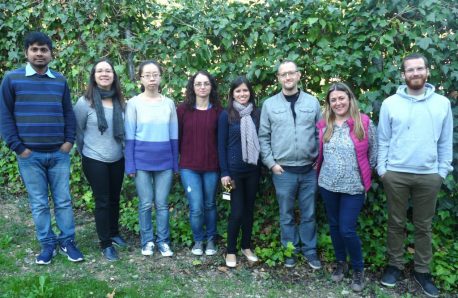Shafir
Research group

Abstract
We are interested in developing new chemical transformations, with particular focus on methodsthat allow rapid complexity build up from simple and inexpensive precursors. During 2016, our main emphasis has been on the new reactivity patterns promoted by a hypervalent iodine group, and which allows for oxidative carbon-carbon and carbon-nitrogen and carbon-halogen bond-forming reactions with the retention of iodine as a “universal” diversification point. While our previous efforts involved reactions proceeding via iodonio-Claisen rearrangement (see the 2015 Report), in 2016 we reported a method for the construction of 1-aryl-5-iodoimidazoles which relies on a new concept of using an iodine(III) center as a directing tether group for the introduction of an aryl fragment (ACIE 2016). The method offer an unusual solution to a long-standing chemical problem: while efficient coupling methods exists for preparing the 1,4-derivatives (e.g. the Buchwald-Hartwig N-arylation), the formation of the hindered 1,5 analogues remains challenging, hence limiting their applications, e.g. as drug candidates. Our new approach is made possible by a new family of imidazole-containing aryliodonium salts, and allows access to a range of 1,5-imidazole derivatives.
At the same time, we have continued exploring the iodonio-Claisen and mechanistically related metal-free transformations, now with the aim of introducing unsaturated hydrocarbyl fragments, including propargyl, homoally and benzyl groups. It appears that the range of mechanisms in this system may allow for selective CH functionalization ortho, para and even meta to iodine. Given that in all cases the ArI(OAc)2 reagent is activated by BF3·Et2O or another acid, in 2016 we also reported a detailed study on the general phenomenon of acid activation of aryliodine dicarboxylates (JACS 2016). In this report, we provide, for the first time, a range of NMR and solid state evidence for the putative PIDA·BF3 complex, assumed as active species in hundreds of transformations reported by groups around the world. A detailed DFT description of the orbital origin of the activation phenomenon is also provided. Finally, in 2016, the group also published a Highlight reviewing the growing synthetic importance and mechanistic parallelism of sulfur- and iodine-directed redox arylation processes (Tetrahedron let. 2016).
Topics addressed
- Halogen-directed oxidative C-I and C-N bond formation.
- Uncovering mechanistic details in acid activation of aryliodine dicarboxylates.
- Unifying the concept of the sulfur- and iodine-based Claisen manifolds.
- Proline as superior modulator in the formation of Zr-based (UiO-type) MOFs
Articles
“NH-Heterocyclic Aryliodonium Salts and their Selective Conversion into N1-Aryl-5-iodoimidazoles”
Angew. Chem. Int. Ed. (2016) 55, 7152 –7156
Y. Wu, S. Izquierdo, P. Vidossich, A. Lledós, A. Shafir
“Modulation by Amino Acids: Toward Superior Control in the Synthesis of Zirconium Metal–Organic Frameworks”
Chem. Eur. J. (2016) 22, 13582 – 13587
O. V. Gutov, S. Molina, E. C. Escudero-Adán, A. Shafir
“The emergence of sulfoxide and iodonio-based redox arylation as a synthetic tool”
Tetrahedron Lett. (2016) 57, 2673–2682
A. Shafir
“Acid Activation in Phenyliodine Dicarboxylates: Direct Observation, Structures, and Implications”
J. Am. Chem. Soc. (2016) 138, 12747–12750
S. Izquierdo, S. Essafi, I. del Rosal, P. Vidossich, R. Pleixats, A. Vallribera, G. Ujaque, A. Lledós, A. Shafir